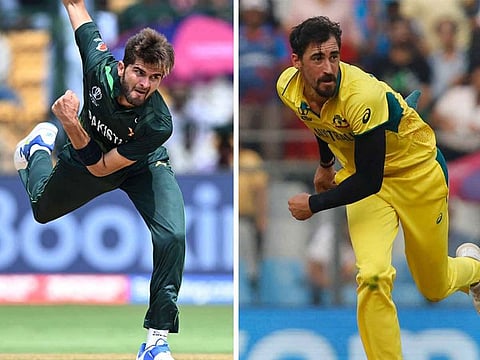Why pacers are bowling slow and spinners quicker in Cricket World Cup
Bowlers try to be one step ahead of batters in difficult conditions

Dubai: The advent of white-ball cricket has put the bowlers under the spotlight, rather in an uncomfortable position.
The batters have got way bolder in their approach and without any hesitation, they go after the leather.
A bowler’s reputation, line, length or the situation of the match could do for nothing. That is the modern batter for you. Sometimes the bowlers and the fielding team go into a brain freeze when they come under such an assault, something similar to what Afghanistan bowlers encountered when Glenn Maxwell hammered the attack with all guns blazing in the World Cup match in Mumbai on Tuesday.
Bowlers need a big heart
Stopping the power-hitters is a difficult task for them. Apart from having a brave heart, they are always under pressure to pull something unique out of their hats, trying several variations and evolving with times. The evolution has taken such deep roots in their thought process that the pace bowlers are refraining from bowling fast, their stock ball, while the spinners rely more on pace rather than the flight and spin.
In the 1970-1980s to the early years of the new millennium, fast bowlers were plying their trade with pride. The cricket ball will wiz past the ears with amazing regularity, sending shivers down the batters’ spine on true wickets. Legends like Michael Holding, Malcolm Marshall, Wasim Akram or Waqar Younis kept steaming in to bowl fast, swinging the ball at tremendous pace.
But today, the fast bowlers depend more on cutters, slower deliveries and knuckleballs, rather than seam and swing, to protect their bowling analysis. Mitchell Starc or Shaheen Shah Afridi, both tall with good pace, still try to rely more on slower variants during this 50-over World Cup.
Staying away from injuries
It is not just the conditions that have forced the pacers to try different deliveries. The increase in the standards of safety equipment and facing throwdowns or bowling machine that sends deliveries in excess of 150 kmph have all contributed in making the current generation batters fearless against pace. In fact, the faster the ball comes at them, the quicker it gets dispatched to the boundary with the aid of the modern day willows. So the pacers rely on cutters with the old ball and more towards the end of the innings to restrict the boundaries and the stop giving away the extra runs.
The other reason for the pacers to rely on variations is to conserve their energies and keep their bodies from breaking down with injuries as they are playing more matches these days. The modern training methods force them to hit the gym more frequently than bowling for long hours at the nets.
Kuldeep Yadav's big change
Similarly, the spinners, worried about the batters stepping out and lofting them over the field, try to bowl quicker to minimise the risk of getting hit. The batters hardly pick the wrist spinners, who are in vogue now than in the past, while the finger spinners have become the victims and are not preferred because the batters could pick their pace and spin easily.
Hence, the spinners operate in the region of late 80kmph to early 90s. India’s Kuldeep Yadav started getting more wickets after bowling faster, and Ravindra Jadeja is quick through the air and off the wicket, giving the batters very little time to react to the spin that he gets from the pitches. New Zealand spinner Mitchell Santner is probably the only one to bowl in the mid-70s, but more often than not, his quicker deliveries get that extra spin and bounce to get the left-armer the wicket.
With more innovations coming from the batters, the bowling will take new shape as the game progresses in the shorter formats.
Sign up for the Daily Briefing
Get the latest news and updates straight to your inbox


